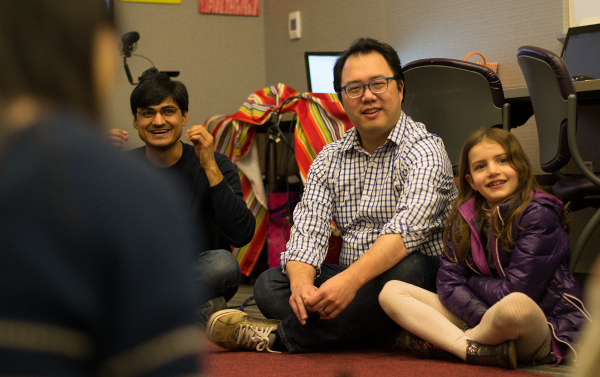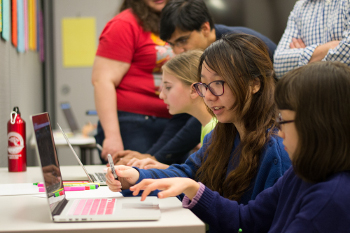
Kids arrive after a day of elementary school, have their snacks, and burn off some energy at playtime. Then they get to work, turning popsicle sticks, glue, paper and markers into make-believe robots.
It may look like an ordinary after-school program, but it’s far from it. These kids are part of KidsTeam UW, and their work is helping to shape technology and learning experiences for other children.
In traditional user testing, children are shown a prototype of a nearly finished product, and testers collect data before sending test subjects on their way. Assistant Professor Jason Yip’s team turns that approach on its head. It gives kids time to develop as skilled testers and involves them earlier in the design process – a method known as Cooperative Inquiry.
“If you look at the models of industry, they run a lot of usability tests, and oftentimes they get it wrong,” Yip said. “With these kids, I see them for a couple months, sometimes a couple years. They start developing an expertise in design, and they are able to articulate what they think about design and how they would make recommendations for changes.”
The idea of co-designing with children is one that Yip carried over to the University of Washington Information School from his doctoral studies under Professor Allison Druin at the University of Maryland. In October 2015, Yip established a “franchise” of sorts for the research with his KidsTeam UW.
The team is composed of 10 kids along with undergraduate and graduate researchers from the iSchool and the Human Centered Design & Engineering department. The kids, ages 7 to 11, spend months or even years honing their skills.
It’s been a busy first school year for KidsTeam UW and its researchers. Among their work so far: partnering with the Seattle Public Library on STEM education programs; helping to redesign BlockStudio, a programming tool that helps kids build games using blocks; developing social media tools for science learning in neighborhoods; and working with Foundry10 to bring the game “Super Mario Maker” to libraries.
“I have taken some of the lessons learned at KidsTeam UW and already implemented them in my programs,” said Juan Rubio, Digital Media and Learning Program Manager for the Seattle Public Library. Rubio has been working with KidsTeam UW to learn how children best respond to the Finch robot, which is designed to introduce them to computer programming.
“Kids are full of ideas that would escape you as an adult,” Rubio said. “I am always surprised at their imagination, creativity and fresh look at things. Since I am creating programs with them in mind, it is extremely valuable to involve them in the design of their learning.”
In their group sessions, kids contribute by being their active selves. They might draw on the user interface to express their opinions, or they might hop from one spot to another around the room to show what they like. The idea is to get them moving, creating and building.
The approach, Yip said, “depends on the stage of the product. If it’s very early and we don’t know what we’re doing, we might ask them to draw a picture of an idea about the technology they envision. Or we might ask them to take art supplies and have them build out just an idea – a prototype.”

The idea of involving children in the early stages of product design may be tough for some traditional companies and organizations to embrace, but Yip noted that Google has embraced the concept. Down the road, he foresees the idea gaining more widespread traction in fields such as game design, libraries, museums and robotics.
So far, KidsTeam UW has worked with educators and nonprofits, but Yip is open to working with businesses as well. While it requires a larger investment of time and money upfront, co-design with kids could head off problems that are much tougher to fix once a product is at the end stages of development.
Ultimately, Yip seeks to find the best ways children and families can contribute to the next generation of technologies for youths.
“I think KidsTeam UW can shape really big things later on, when it comes to technology and learning,” Yip said. “We’ve only scratched the surface of it.”